Layer-by-Layer Self-Assembling Gold Nanorods and Glucose Oxidase onto Carbon Nanotubes Functionalized Sol-Gel Matrix for an Amperometric Glucose Biosensor
Abstract
:1. Introduction
2. Results and Discussion
2.1. Preparation and Morphology Characterization
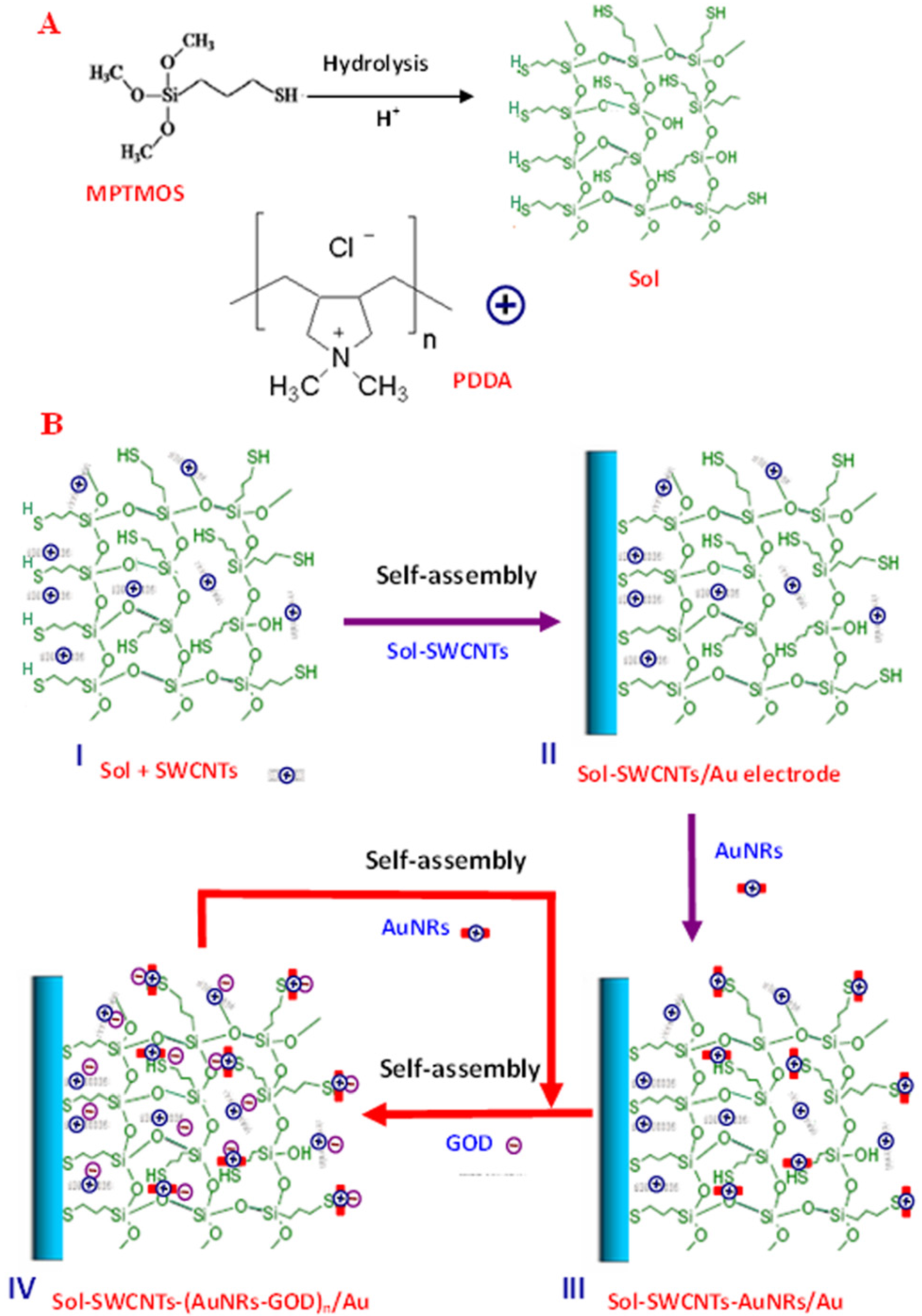
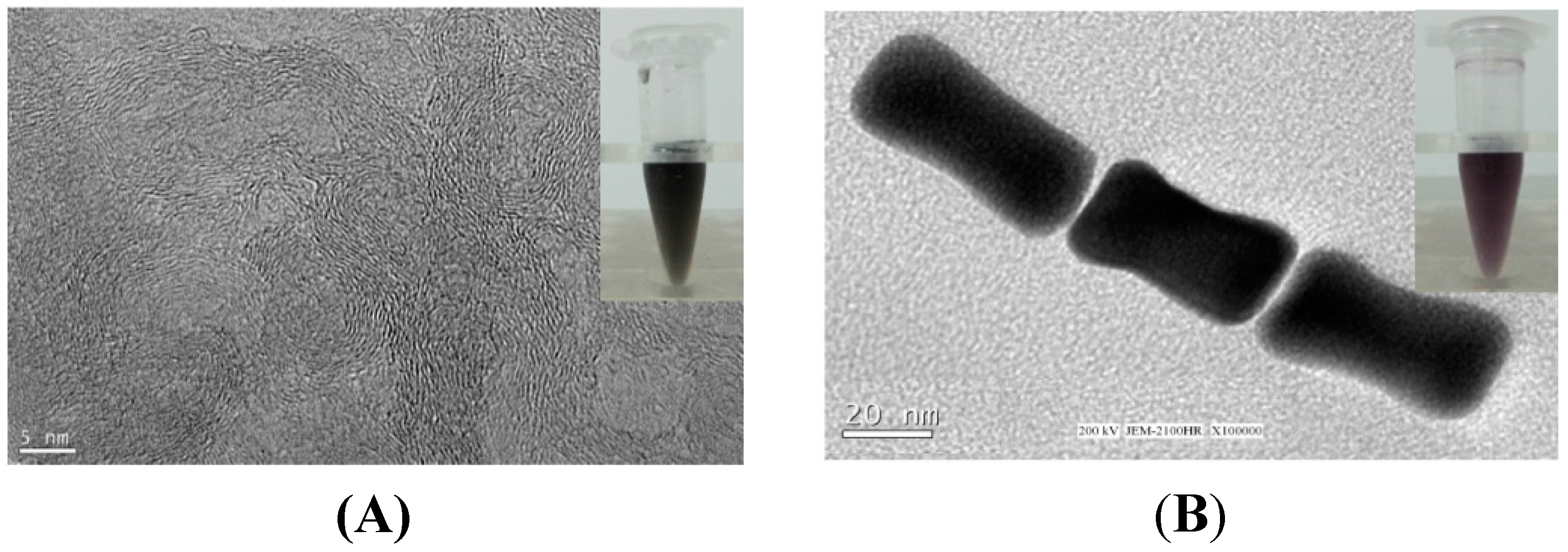
2.2. UV-Vis Analysis
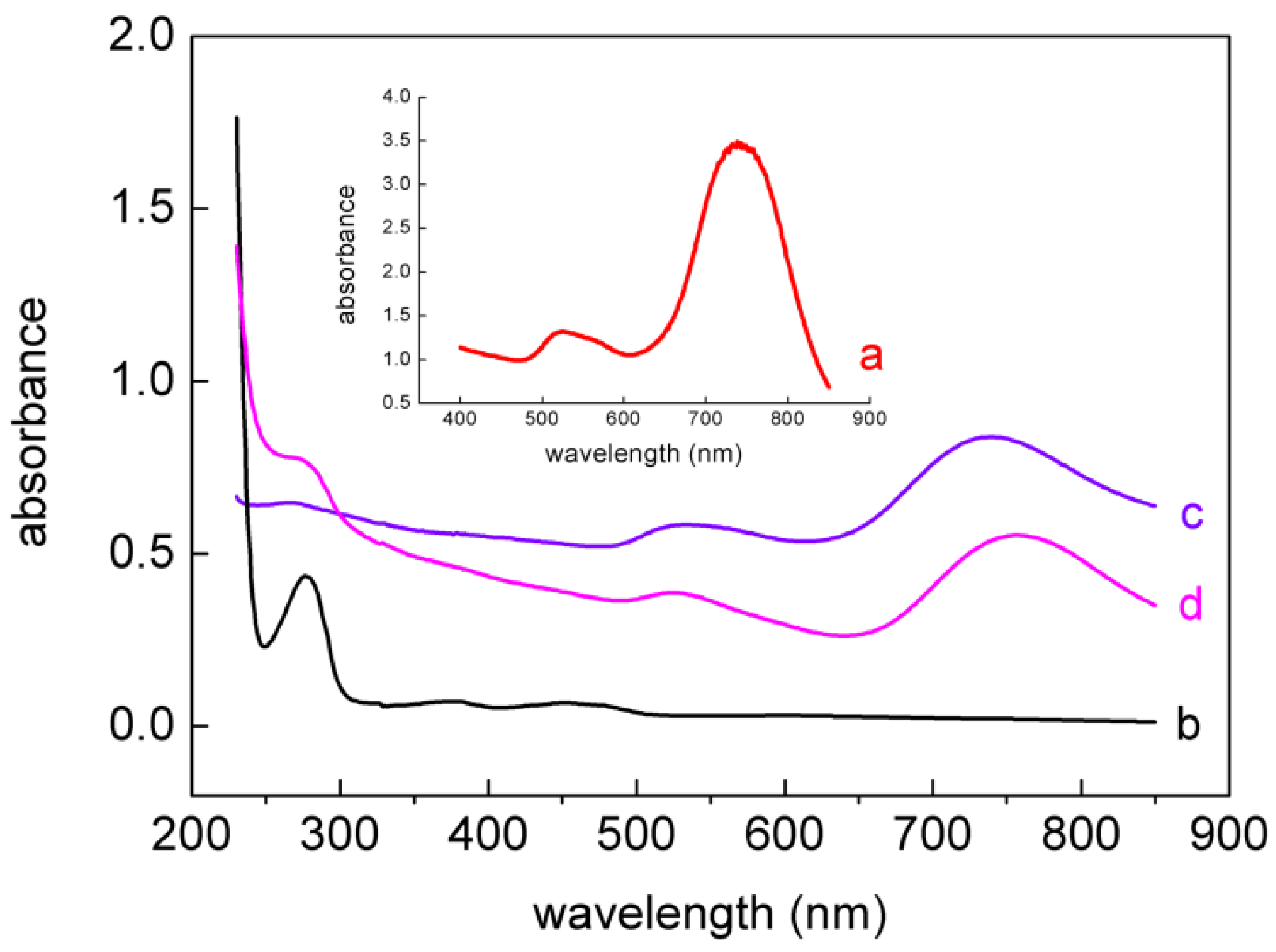
2.3. Cyclic Voltammetric Characterization
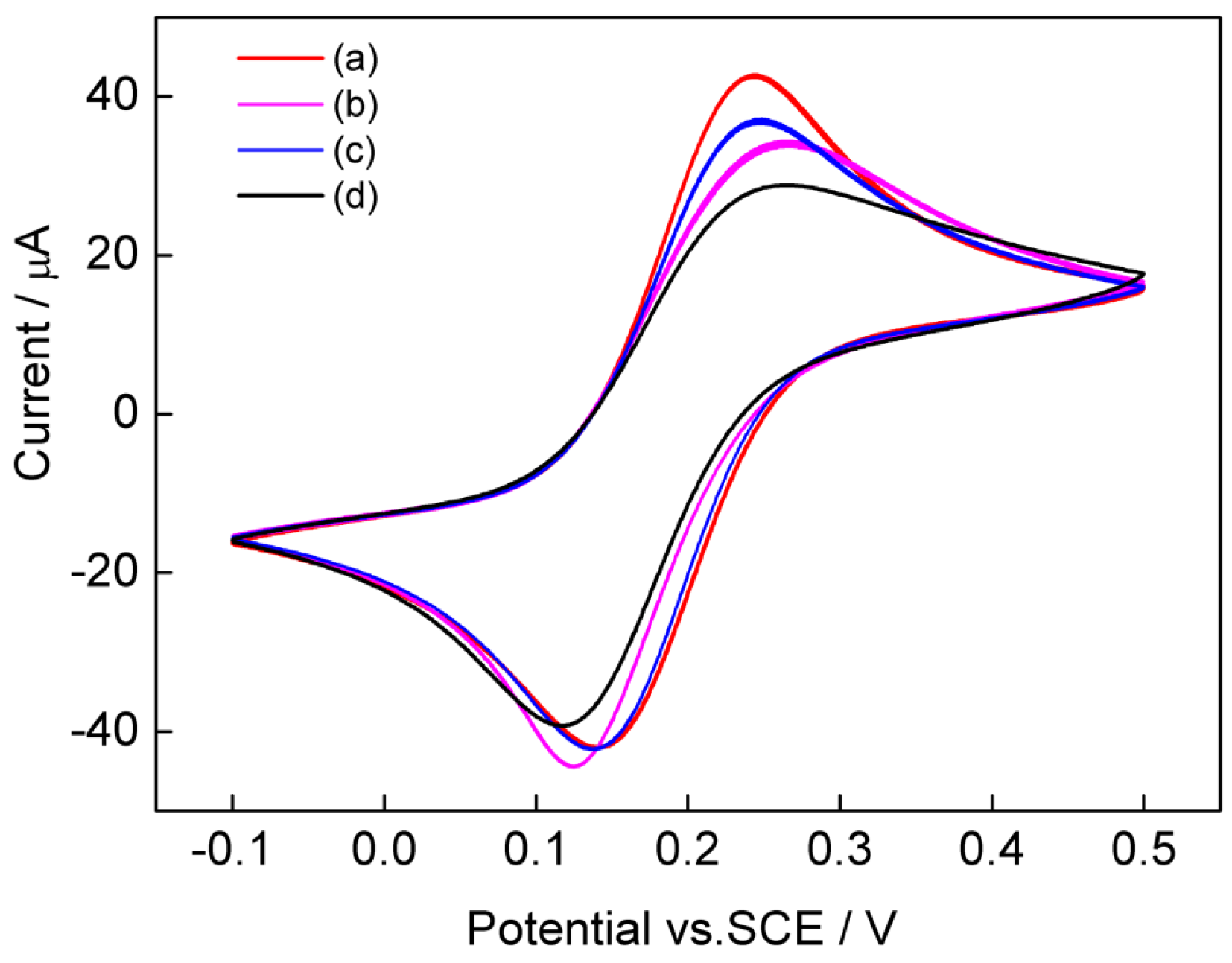
2.4. Effect of AuNRs-GOD Multilayers
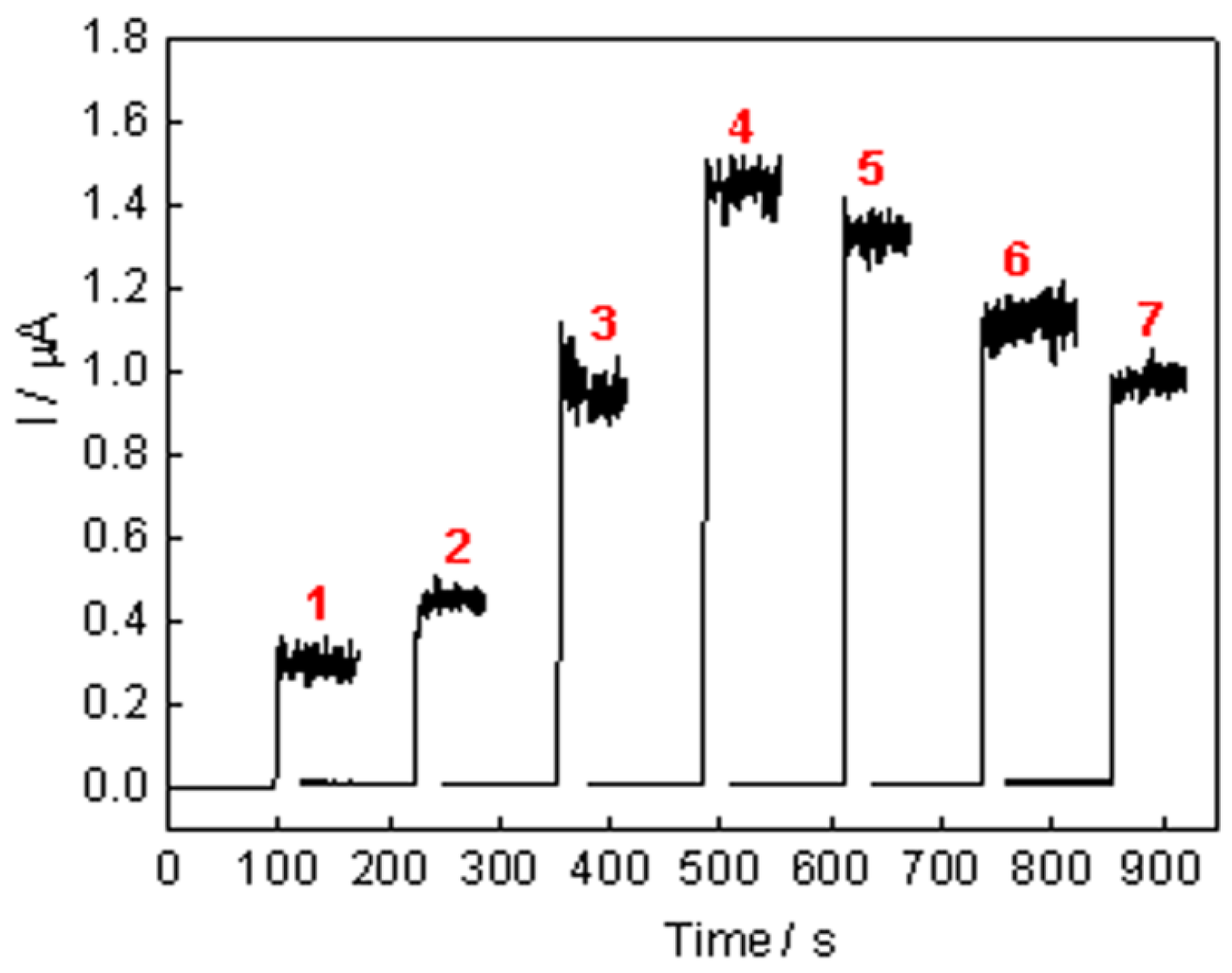
2.5. Chronoamperometric Response

2.6. Selectivity, Reproducibility, and Stability
3. Experimental Section
3.1. Reagents
3.2. Apparatus and Measurements
3.3. Preparation of the Glucose Biosensor
3.3.1. Preparation of PDDA-AuNRs and Sol-SWCNTs
3.3.2. Configuration of the Glucose Biosensor
4. Conclusions
Acknowledgments
Author Contributions
Conflicts of Interest
References
- Guo, X.S.; Liang, B.; Jian, J.M.; Zhang, Y.L.; Ye, X.S. Glucose biosensor based on a platinum electrode modified with rhodium nanoparticles and with glucose oxidase immobilized on gold nanoparticles. Microchim. Acta 2014, 181, 519–525. [Google Scholar] [CrossRef]
- Lad, U.; Kale, G.M.; Bryaskova, R. Glucose oxidase encapsulated polyvinyl alcohol silica hybrid films for an electrochemical glucose sensing electrode. Anal. Chem. 2013, 85, 6349–6355. [Google Scholar] [CrossRef] [PubMed]
- Unnikrishnan, B.; Palanisamy, S.; Chen, S.M. A simple electrochemical approach to fabricate glucose a biosensor based on graphene–glucose oxidase biocomposite. Biosens. Bioelectron. 2013, 39, 70–75. [Google Scholar] [CrossRef] [PubMed]
- Jung, J.; Lim, S. ZnO nanowire-based glucose biosensors with different coupling agents. Appl. Surf. Sci. 2013, 265, 24–29. [Google Scholar] [CrossRef]
- Guo, M.Q.; Fang, H.D.; Wang, R.; Yang, Z.Q.; Xu, X.H. Electrodeposition of chitosan-glucose oxidase biocomposite onto Pt-Pb nanoparticles modified stainless steel needle electrode for amperometric glucose biosensor. J. Mater. Sci. Mater. Med. 2011, 22, 1985–1992. [Google Scholar] [CrossRef] [PubMed]
- Szot, K.; Jönsson-Niedziolka, M.; Rozniecka, E.; Marken, F.; Opallo, M. Direct electrochemistry of adsorbed proteins and bioelectrocatalysis at film electrode prepared from oppositely charged carbon nanoparticles. Electrochim. Acta 2013, 89, 132–138. [Google Scholar] [CrossRef]
- Jin, L.Y.; Gao, X.; Chen, H.; Wang, L.S.; Wu, Q.; Chen, Z.C.; Lin, X.F. Efficient immobilization of glucose oxidase on nanocomposite via layer-by-layer self-assembly to construct bionanomultilayer films. J. Electrochem. Soc. 2013, 160, 6–12. [Google Scholar] [CrossRef]
- Poudel, P.; Qiao, Q.Q. One dimensional nanostructure/nanoparticle composites as photoanodes for dye-sensitized solar cells. Nanoscale 2012, 4, 2826–2838. [Google Scholar] [CrossRef] [PubMed]
- Ren, X.L.; Chen, D.; Meng, X.W.; Tang, F.Q.; Du, A.M.; Zhang, L. Amperometric glucose biosensor based on a gold nanorods/cellulose acetate composite film as immobilization matrix. Colloid Surface. B. 2009, 72, 188–192. [Google Scholar] [CrossRef] [PubMed]
- Wang, Y.S.; Zhang, D.H.; Liu, W.; Zhang, X.; Yu, S.X.; Liu, T.; Zhang, W.T.; Zhu, W.X.; Wang, J.H. Facile colorimetric method for simple and rapid detection of endotoxin based on counterion-mediated gold nanorods aggregation. Biosens. Bioelectron. 2014, 55, 242–248. [Google Scholar] [CrossRef] [PubMed]
- Wang, C.G.; Ma, Z.F.; Wang, T.T.; Su, Z.M. Synthesis, assembly, and biofunctionalization of silica-coated gold nanorods for colorimetric biosensing. Adv. Funct. Mater. 2006, 16, 1673–1678. [Google Scholar] [CrossRef]
- Komathi, S.; Gopalan, A.I.; Kim, S.K.; Anand, G.S.; Lee, K.P. Fabrication of horseradish peroxidase immobilized poly (N-[3-(trimethoxy silyl)propyl]aniline) gold nanorods film modified electrode and electrochemical hydrogen peroxide sensing. Electrochim. Acta 2013, 92, 71–78. [Google Scholar] [CrossRef]
- Vigderman, L.; Khanal, B.P.; Zubarev, E.R. Functional gold nanorods: Synthesis, self-assembly, and sensing applications. Adv. Mater. 2012, 24, 4811–4841. [Google Scholar] [CrossRef] [PubMed]
- Li, Y.C.; Wang, F.; Huang, F.Y.; Li, Y.J.; Feng, S.Q. Direct electrochemistry of glucose oxidase and its biosensing to glucose based on the Chit-MWCNTs-AuNRs modified gold electrode. J. Electroanal. Chem. 2012, 685, 86–90. [Google Scholar] [CrossRef]
- Arvand, M.; Gholizadeh, T.M. Gold nanorods-graphene oxide nanocomposite incorporated carbon nanotube paste modified glassy carbon electrode for voltammetric determination of indomethacin. Sensors Actuators B 2013, 186, 622–632. [Google Scholar] [CrossRef]
- SantosSilva, F.A.; AngelodaSilva, M.G.; Lima, P.R.; Meneghetti, M.R.; Kubota, L.T.; Goulart, M.F. A very low potential electrochemical detection of l-cysteine based on a glassy carbon electrode modified with multi-walled carbon nanotubes/gold nanorods. Biosens. Bioelectron. 2013, 50, 202–209. [Google Scholar]
- Bao, Y.; Vigderman, L.; Zubarev, E.R.; Jiang, C.Y. Robust multilayer thin films containing cationic thiol-functionalized gold nanorods for tunable plasmonic properties. Langmuir 2012, 28, 923–930. [Google Scholar] [CrossRef] [PubMed]
- Li, W.K.; Zhang, P.; Dai, M.; He, J.; Babu, T.; Xu, Y.L.; Deng, R.H.; Liang, R.J.; Lu, M.H.; Nie, Z.H.; et al. Ordering of gold nanorods in confined spaces by directed assembly. Macromolecules 2013, 46, 2241–2248. [Google Scholar] [CrossRef]
- Jia, J.; Wang, B.; Wu, A.; Cheng, G.; Li, Z.; Dong, S. A method to construct a third-generation horseradish peroxidase biosensor: Self-assembling gold nanoparticles to three-dimensional sol-gel network. Anal. Chem. 2002, 74, 2217–2223. [Google Scholar] [CrossRef] [PubMed]
- Hou, S.H.; Ou, Z.M.; Chen, Q.; Wu, B.Y. Amperometric acetylcholine biosensor based on self-assembly of gold nanoparticles and acetylcholine esterase on the sol-gel/multi-walled carbon nanotubes/choline oxidase composite-modified platinum electrode. Biosens. Bioelectron. 2012, 33, 44–49. [Google Scholar] [CrossRef] [PubMed]
- Nie, Z.H.; Petukhova, A.; Kumacheva, E. Properties and emerging applications of self-assembled structures made from inorganic nanoparticles. Nat. Nanotechnol. 2010, 5, 15–25. [Google Scholar] [CrossRef] [PubMed]
- Wu, B.Y.; Hou, S.H.; Yin, F.; Li, J.; Zhao, Z.X.; Huang, J.D.; Chen, Q. Amperometric glucose biosensor based on layer-by-layer assembly of multilayer films composed of chitosan, gold nanoparticles and glucose oxidase modefied Pt electrode. Biosens. Bioelectron. 2007, 22, 838–844. [Google Scholar] [CrossRef] [PubMed]
- Qu, F.L.; Zhang, Y.; Rasooly, A.; Yang, M.H. Electrochemical biosensing platform using hydrogel prepared from ferrocence modified amino acid as highly efficient immobilization. Anal. Chem. 2014, 86, 973–976. [Google Scholar] [CrossRef] [PubMed]
- Zhang, J.J.; Liu, Y.G.; Jiang, L.P.; Zhu, J.J. Synthesis, characterizations of silica-coated gold nanorods and its applications in electroanalysis of hemoglobin. Electrochem. Commun. 2008, 10, 355–358. [Google Scholar] [CrossRef]
- Cai, H.H.; Lin, D.W.; Wang, J.H.; Yang, P.H.; Cai, J.Y. Controlled side-by-side assembly of gold nanorods: A strategy for lead detection. Sensors Actuators B 2014, 196, 252–259. [Google Scholar] [CrossRef]
- Zhou, K.F.; Zhu, Y.H.; Yang, X.L.; Li, C.Z. Electrocatalytic oxidation of glucose by the glucose oxidase immobilized in graphene-Au-Nafion biocomposite. Electroanalysis 2010, 22, 259–264. [Google Scholar] [CrossRef]
- Hasan, K.U.; Asif, M.H.; Hassan, M.U.; Sandberg, M.O.; Nur, O.; Willander, M.; Fagerholm, S.; Strålfors, P. A miniature graphene-based biosensor for intracellular glucose measurements. Electrochim. Acta 2015, 174, 574–580. [Google Scholar] [CrossRef]
- Wu, B.Y.; Hou, S.H.; Yin, F.; Zhao, Z.X.; Wang, Y.Y.; Wang, X.S.; Chen, Q. Amperometric glucose biosensor based on multilayer films via layer-by-layer self-assembly of multi-wall carbon nanotubes, gold nanoparticles and glucose oxidase on the Pt electrode. Biosens. Bioelectron. 2007, 22, 2854–2860. [Google Scholar] [CrossRef] [PubMed]
- Wang, Y.Y.; Wang, X.S.; Wu, B.Y.; Zhao, Z.X.; Yin, F.; Li, S.; Qin, X.; Chen, Q. Dispersion of single-walled carbon nanotubes in poly(diallyldimethylammonium chloride) for preparation of a glucose biosensor. Sensors Actuators B 2008, 130, 809–815. [Google Scholar] [CrossRef]
- Nenkova, R.; Ivanova, D.; Vladimirova, J.; Godjevargova, T. New amperometric glucose biosensor based on cross-linking of glucose oxidase on silica gel/multiwalled carbon nanotubes/polyacrylonitrile nanocomposite film. Sensors Actuators B 2010, 148, 59–65. [Google Scholar] [CrossRef]
- He, C.X.; Liu, J.H.; Zhang, Q.L.; Wu, C. A novel stable amperometric glucose biosensor based on the adsorption of glucose oxidase on poly(methyl methacrylate)-bovine serum albumin core-shell nanoparticles. Sensors Actuators B 2012, 166, 802–808. [Google Scholar] [CrossRef]
- Kotanen, C.N.; Tlili, C.; Guiseppi-Elie, A. Amperometric glucose biosensor based on electroconductive hydrogels. Talanta 2013, 103, 228–235. [Google Scholar] [CrossRef] [PubMed]
- Rogers, M.J.; Brandt, K.G. Interaction of d-glucal with Aspergillus niger glucoseoxidase. Biochemistry 1971, 10, 4624–4630. [Google Scholar] [CrossRef] [PubMed]
- Nikoobakht, B.; El-Sayed, M.A. Preparation and growth mechanism of gold nanorods using seed-mediated growth method. Chem. Mater. 2003, 15, 1957–1962. [Google Scholar] [CrossRef]
- Wang, B.; Li, B.; Deng, Q.; Dong, S.J. Amperometric biosensor based on sol-gel organic-inorganic hybrid material. Anal. Chem. 1998, 70, 3170–3174. [Google Scholar] [CrossRef] [PubMed]
© 2015 by the authors; licensee MDPI, Basel, Switzerland. This article is an open access article distributed under the terms and conditions of the Creative Commons Attribution license (http://creativecommons.org/licenses/by/4.0/).
Share and Cite
Wu, B.; Hou, S.; Miao, Z.; Zhang, C.; Ji, Y. Layer-by-Layer Self-Assembling Gold Nanorods and Glucose Oxidase onto Carbon Nanotubes Functionalized Sol-Gel Matrix for an Amperometric Glucose Biosensor. Nanomaterials 2015, 5, 1544-1555. https://doi.org/10.3390/nano5031544
Wu B, Hou S, Miao Z, Zhang C, Ji Y. Layer-by-Layer Self-Assembling Gold Nanorods and Glucose Oxidase onto Carbon Nanotubes Functionalized Sol-Gel Matrix for an Amperometric Glucose Biosensor. Nanomaterials. 2015; 5(3):1544-1555. https://doi.org/10.3390/nano5031544
Chicago/Turabian StyleWu, Baoyan, Shihua Hou, Zhiying Miao, Cong Zhang, and Yanhong Ji. 2015. "Layer-by-Layer Self-Assembling Gold Nanorods and Glucose Oxidase onto Carbon Nanotubes Functionalized Sol-Gel Matrix for an Amperometric Glucose Biosensor" Nanomaterials 5, no. 3: 1544-1555. https://doi.org/10.3390/nano5031544




